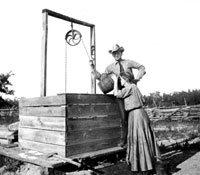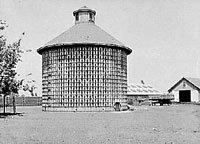
These two trends, industrialized farming with the resulting depopulation of the countryside, and the urban imagination of the rural as an open space, have paired and conflicted in interesting ways. Industrialized farming has brought a uniformity to the landscape with its giant machines and their ability to manage thousands of acres. The urban aesthetic promotes tourism as development to rural regions, emphasizing clean air and water, open spaces and tidiness. When the industrial imperative of bigger falls into conflict with the idea of the imagined open spaces, as in the case with industrial hog farming, it is predictable that the conflict will be long and tumultuous. In some ways these foes join, as in preservation efforts for buildings and structures and, uneasily, in regional planning commissions on land use.
Looking at the landscape, as a photographer, I am drawn into the meaning of these conflicts. I am also drawn to the evidence of the past in the built landscape that remains. I am not moved by an interest in nostalgia or the picturesque, but rather to attempt to reveal the decisions of the past; to compare and contrast and sometimes to upset the prevailing assumptions. The Illinois countryside is still replete with the evidence of its history, often standing side by side with its modern equivalent. But the significant artifacts on the landscape of the 21st century are there to be seen today:
continued
Looking at the landscape, as a photographer, I am drawn into the meaning of these conflicts. I am also drawn to the evidence of the past in the built landscape that remains. I am not moved by an interest in nostalgia or the picturesque, but rather to attempt to reveal the decisions of the past; to compare and contrast and sometimes to upset the prevailing assumptions. The Illinois countryside is still replete with the evidence of its history, often standing side by side with its modern equivalent. But the significant artifacts on the landscape of the 21st century are there to be seen today:
continued


| PAGE |<< | 1 | 2 | 3 | 4 | 5 | 6 | 7 | 8 | 9 | | ||
| D. Gorton's Home Page Jane Adams' Home Page Memory and Judgment: Mississippi The White South Contact Us |
|||||||||
|
This page was last modified on:
|
|||||||||